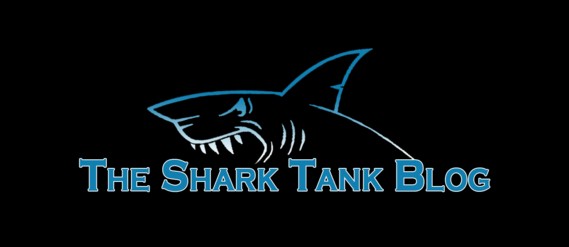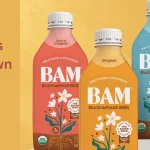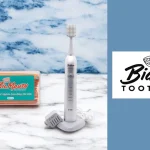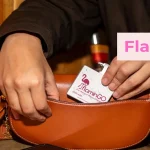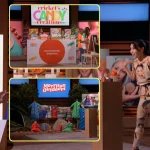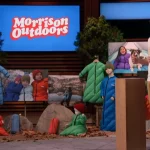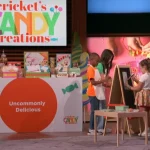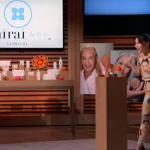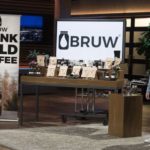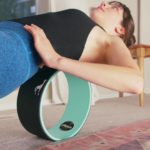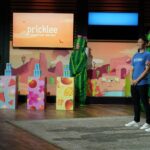Beyond the Tank Episode 106
 Beyond the Tank episode 106 aired January 14, 2016. It is the third episode of the “second season” of the hit show. Three past Shark Tank companies get an in-depth, 20 minute update segment on what their life is like after Shark Tank and viewers get to see them interacting with their investor/sharks. Beyond the Tank episode 106 features a look at Lori Grenier’s meeting with Sal DePaola, John DePaola, and Anthony Caputo from The Paint Brush Cover. Lori invested $200K for 10% of the business back in season five and she managed to get the product on the shelves in over 2000 Home Depot Stores. Robert Herjavec pays a visit to Mark and Hanna Lim from Lollacup. Robert and Mark Cuban invested $100K for 15% of the business back in season three. Robert visits the Lims to help them get their sales back on track. Dan and Liz Holtz left the Tank without a deal for Liz Lovely cookies in season 4, and they return to tell the story of what happened afterwards.
Beyond the Tank episode 106 aired January 14, 2016. It is the third episode of the “second season” of the hit show. Three past Shark Tank companies get an in-depth, 20 minute update segment on what their life is like after Shark Tank and viewers get to see them interacting with their investor/sharks. Beyond the Tank episode 106 features a look at Lori Grenier’s meeting with Sal DePaola, John DePaola, and Anthony Caputo from The Paint Brush Cover. Lori invested $200K for 10% of the business back in season five and she managed to get the product on the shelves in over 2000 Home Depot Stores. Robert Herjavec pays a visit to Mark and Hanna Lim from Lollacup. Robert and Mark Cuban invested $100K for 15% of the business back in season three. Robert visits the Lims to help them get their sales back on track. Dan and Liz Holtz left the Tank without a deal for Liz Lovely cookies in season 4, and they return to tell the story of what happened afterwards.
Each Episode of Beyond the Tank has these “back stories.” We’ll recap them here.
Beyond the Tank Episode 106 Featured Entrepreneurs
- Company – The Paint Brush Cover
- Company – Lollacup
- Company – Liz Lovely Cookies
Beyond the Tank Episode 106 Recap
The Paint Brush Cover
Cousins John and Sal DePaola and their friend Anthony Caputo brought their business, The Paint Brush Cover, to the Shark Tank in Season 5. They were originally scheduled to pitch on an episode when Lori Greiner was not present, but convinced the producers to allow them to change their appearance. Their determination paid off. Lori loved the product, and gave them a deal, offering them $100,000 in exchange for 20% of the business.
Lori is excited about her investment. “I chose to invest in The Paint Brush Cover for several reasons. I thought; This is a great product. It is something that solves a problem, it’s inexpensive, it covers a broad cross-section of people that will buy it and need it, and it was something that we could make and market easily.”
Anthony recalls, “Prior to Shark Tank, it was a little bit of a struggle. We knew the product worked, we knew everyone would love it. It was just hard to get it out there.”
Before appearing on Shark Tank, they’d done $40,000 in sales, selling about 25,000 units. The Shark Tank effect blew those numbers up. Since their appearance, the partners have sold over ½ a million units, with sales topping $2 million.
There’s a snag. “Almost immediately after striking the deal with Lori, she brought up the fact that we need to change the packaging,” says Sal. “That was the last thing I wanted to hear.” John disagrees. He wants to listen to Lori’s suggestions and move the brand forward.
Lori comes to the table with her usual diplomacy. She brings up the packaging right away. “While I’m not saying there’s anything really horrible about it; it’s just not strong enough. It’s not what we’re going to need to really get into retail and really take it to the level that’s important.”
Sal is resistant to the idea of change. “I’m definitely emotionally attached to [the old packaging],” he explains. “I helped create it, along with Anthony, and I thought we did a great job on it.”
Lori feels that there’s a need to grab the customer’s attention as they walk down the store aisles, and that the customer needs to understand immediately what the product is and how to use it.
Sal takes a different tactic, pointing out that the brand has been represented by “blue and yellow” for three years. Lori stays focused, responding that, according to the numbers, “this is the right time to make that change.”
She shows them images of the proposed new designs. Lori believes the packaging should change to a red background, that the color will “pop” more, pointing out that Stop signs are red for that reason.
Sal remains unconvinced. “I just don’t see my product being red. I’m not loving the red.”
John disagrees. He likes the red and wants to embrace the new logo.
Since the pair are butting heads and it’s clear that no immediate consensus can be reached, Lori leaves the three of them to work out the final decision, telling them that she’ll need to know “within the next couple of days.”
John tries to talk Sal into the red, but Sal and Anthony are dedicated to blue and yellow, arguing that customers recognize the blue and yellow. The trio had visited Home Depot and chose blue in order to stand out from the myriad of yellow and red packaging.
John believes that Lori’s advice is solid. “I’m changing it on the advice of an expert,” he argues, “Who says that this isn’t what it needs to be.”
The conversation degenerates into an argument, and John walks out on the other two. He calls Lori to let her know about the lack of progress.
Lori has a solution. “I have a little test,” she says, “That I know is going to convince them.”
She takes the three of them to a Home Depot, and has them walk around the store, and come back to see their own product hanging among the other paintbrush products. Reluctantly, Anthony admits that the Paint Brush Cover was slower to catch his eye.
Lori repeats the experiment, hanging a prototype of the red packaging. When the trio return, the change in attitude is clear. They get what Lori is trying to show them, and recognize the difference in the professionally created packaging over their old blue and yellow.
“I get that you’re afraid to change this,” Lori tells them. “You don’t want to lose who you’ve had. But, we have to gain who’s coming, and that’s such bigger sales. Let’s say we get into Home Depot. If it doesn’t move, we’re done. I feel confident… This is a great product, so if it pops and people see it, they’re going to buy it.”
Sal, in spite of his initial resistance, accepts the change. “When I see this [red packaging] next to this [blue packaging], the blue looks like something from the 80s.”
Changing the packaging is a huge job, but they pull it off in time for the Emory Waterhouse trade show, where they present the product to small, mid-sized, and large retail sellers.
As reluctant as Sal was in the beginning, he is confident in the change now. “After the hard work, the long hours, the money spent, everything that we had to do to get it ready, it’s unbelievable to see what we could accomplish in so little time.”
The Paint Brush cover made it into all Home Depot stores nationwide, and Lori believes the next step is to go international.
“We truly are family,” says Sal of The Paint Brush Cover partners. “There’s nothing we wouldn’t do for one other, and I cannot wait to see what’s in store for the future of this company.”
Liz Lovely Cookies
Liz and Dan Holtz came to the Shark Tank in season 4 to present Liz Lovely Cookies. In spite of some lukewarm interest from Mark Cuban, the pair left the Shark Tank with no deal on their gluten and dairy-free, vegan cookies.
“Pitching on Shark Tank was extremely nerve-wracking, and really exciting,” remembers Liz. She was surprised that the Sharks didn’t like the cookies, and devastated by the failure. “We did not walk out with a deal. I don’t think the marketplace was ready for gluten-free. It’s three years later, and I think things are very different now.”
The year before Shark Tank, Liz Lovely did nearly $1 million in sales, and the year following, the sales increased to almost $2 million, doubling their sales numbers. In spite of those gains, and the adoption of their second child, the couple’s eighteen year old marriage did not survive. The couple has divorced, and Dan has left the company.
Liz has decided to go forward with her business. “I am all in with Liz Lovely,” she says. “Everything is at stake if this company is not successful. I work as hard as I do for my kids. I want them to see what it looks like to follow your dreams, and I want them to learn how to believe in themselves, because I think it’s taken me way too long to learn that lesson.”
With the divorce, the branding needs to change. Liz Lovely was presented as a family business, with Liz and Dan being presented as the face of the company. Liz is having to completely revamp her presentation and sales strategies.
She goes to a local ski resort to hold a launch for a new line: cookie truffles. “Some Sharks didn’t like our cookies, but I’m hoping that something enrobed in chocolate, I mean, how do you not love that?”
The launch goes well, and the new line is a success. Liz Lovely is on track to clear $2.7 million in sales in the coming year.
“Before Shark Tank,” says Liv, “I didn’t really know who Liz Lovely was. After Shark Tank, and with recent events, I now have a very clear picture of who Liz Lovely is. We have so much opportunity ahead of us and we are going to be successful no matter what.”
LollaCup
When Mark and Hanna Lim came to the Shark Tank in Season 3 to pitch their LollaCup, they managed to land not one, but two Sharks, doing a joint deal with Robert Herjavec and Mark Cuban. They couldn’t have known then, that their business would grow, then plateau, as they faced one of the most difficult phases of their lives together.
“I love the LollaCup folks. I felt they were fully committed, and that’s a beautiful sippy cup,” says Robert.
The Shark Tank effect boosted their sales, propelling the couple’s business from their garage into a warehouse and office. Unfortunately, the initial promising sales boost soon flat-lined.
“When Hannah gave birth to our third girl,” explains Mark, “She became severely ill. We never really told our Sharks about Hanna’s condition and what we were going through, because when you’re in business, you find a way to make it through.”
Robert is coming out to visit. He wants to know why the sales have stopped growing. The Lims are looking forward to the meeting, too. They want to talk to Robert about how to rebuild their sales trajectory and regain the ground they’ve lost to Hanna’s illness.
Robert wants to know what’s been going on with the company, and the couple explain, for the first time, what happened. Hanna had a severe reaction to a steroid skin treatment. She brings out photos of the progression, showing clearly the incredible toll the problem took on her health, both physical and emotional.
Robert is shocked into emotion by the photos. He hugs Hanna. “My gosh,” says Robert. “I don’t think that people realize that having a business is like having another child. It’s a living, breathing thing. You don’t have the luxury of saying, oh hang on, my wife’s sick. I mean, it’s so hard.” Their story touched Robert, and he’s impressed with their tenacity. The couple did $810,000 during the year Hanna was ill, almost doubling their sales in spite of the setbacks.
When Hanna was well, they launched a mealtime set, hoping to kick-start the sales, but the campaign hasn’t taken off as they’d first hoped. Mark and Hanna want Robert’s advice for moving forward. They present Robert with prototypes of their newest product, a heavy glass bottle, designed to eliminate colic with a special nipple, and with no chance of leaching chemicals when the bottle is heated, unlike plastics.
Mark has been talking to the salesperson for Bye Bye Baby, a Bed Bath and Beyond division. Getting into that retail space would almost double their sales.
“I almost feel like you’re a little too nice,” says Robert. “But in business, you’ve got to go for the throat sometimes. One of the things I’m going to challenge you with is, stop being so nice.” He encourages Mark to pressure the Bye Bye Baby salesperson for a purchase order.
“When I look at these numbers,” admits Mark, “It makes me angry.”
Robert affirms his instinctive response to the low sales. “I want you to be angry, Mark. If anybody has more of a right to be angry, shouldn’t it be you? You start this business, your wife gets ill, life throws a big curve for you. Don’t take it lying down. You should be angry. You should be screaming from the rooftop, and those numbers are embarrassing to you. If you’re going to play this game, why not play it to win? I can’t believe you went through this pain to wake up one day and pat yourself on the back and say, “We’re good.” Be better than good. Be great.”
Armed with Robert’s encouragement and support, Mark and Hanna move forward. They decide to run a focus group on the Mealtime set in their home, and invite Robert to attend.
“All the pieces are there,” says Hanna. “I just think we need to take that next step.”
Mark agrees. “We’re hungry. We’ve got teeth.”
Robert is excited to take part in the focus group. Hanna brings a group of women and their small children to her home to examine the new product and give feedback.
“I’m so excited to be coming back to the focus group,” says Robert, “because I get to see actual buyers of the product. Plus, I get a room full of babies. Who doesn’t love babies?”
Robert drops his sharp-toothed Shark façade in the face of a half-dozen toddlers, tickling a little boy and making him giggle. Robert’s clearly enjoying interacting with his youngest customers.
Hanna gets feedback on the packaging. They need to make the anti-colic aspect of the new bottles clearer. The moms also agree that the line needs a wider variety of products.
“Maybe the answer to double sales is not one product growing by 80%. Maybe the answer is 10 products, each growing by 6% market share,” says Robert. He’s on board to launch new products. He’s less enthusiastic about giving back the baby he’s been playing with, making the moms laugh and charming mothers and children alike.
At the end of the day, the Shark is all about business. “Now,” he says, “It’s all about execution.”
The pair is ready to move forward. Hanna works to improve the packaging, and they consider packaging the Mealtime set with a LollaCup as a marketing strategy.
They go to their largest customer, Right Start, and present the new bottle to the store manager. She’s not an easy sale. “There is a lot of glass bottles out there in the marketplace, and it is a competitive field for us right now.” She’s willing to take a look, however, and Hanna emphasizes the anti-colic nipple.
“Knowing our customers, it probably is something that they will buy,” says the manager. She agrees to get the bottles on the shelves.
Mark is encouraged by the success. “There were times, early on in the business,” he admits, “When I had a hard time looking in the mirror. To just look at myself and say, man, you’re just risking all this. You’ve got little kids sleeping in the bed in the next room, and you’re not even sure if you can pay next month’s rent.”
They did get the purchase order from Right Start, and, Hanna smiles as she reveals, a purchase order from Bye Bye Baby as well. She’s enthusiastic about Lolla Land’s future. “I have that renewed sense of motivation, and I hope that we can meet our lofty goals in the next year by pounding the pavement.”
Mark agrees. “It’s a long hard road,” he says, “but once we get there, I think it’ll be all that much more glorious. We’re ready for it.”

